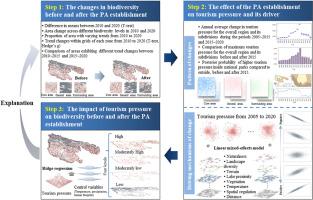基于旅游压力的保护区建设对生物多样性的影响——以三江源国家公园为例
IF 10
1区 环境科学与生态学
Q1 ENGINEERING, ENVIRONMENTAL
引用次数: 0
摘要
建立保护区和可持续发展保护区旅游业对于平衡生物多样性保护(可持续发展目标15)和减轻贫困(可持续发展目标1)至关重要。然而,保护区的建立对旅游业以及因此对生物多样性产生影响的机制仍不清楚,特别是保护区及其周边地区的不同影响。本研究以2005 - 2020年三江源国家公园及其周边地区为研究对象,通过旅游压力分析保护区建设对生物多样性的影响。结果表明,保护区的建立通过缓解旅游压力显著改善了保护区内的生物多样性。PA的建立使生物多样性增加了约5.8%。然而,在某些周边地区,旅游业压力的减轻对生物多样性产生了负面影响,这可能是由于旅游业作为一种替代生计的减弱和传统生计的加强,从而损害了生物多样性。本研究加深了对保护区建设对旅游压力和生物多样性影响机制的理解,为优化保护区的旅游开发和生物多样性保护策略,支持可持续发展目标的实现提供参考。本文章由计算机程序翻译,如有差异,请以英文原文为准。


The impact of protected area establishment on biodiversity via tourism pressure: a case study in Three-river-source National Park, China
Establishing protected areas (PAs) and sustainably developing PA tourism are critical for balancing biodiversity conservation (SDG 15) and poverty alleviation (SDG 1). However, the mechanisms by which the establishment of PAs influences tourism and, consequently, biodiversity remain unclear, particularly regarding the differing impacts within PAs and their surrounding areas. This study examines Three-River-Source National Park in China and its surrounding areas to analyze the effects of PA establishment on biodiversity via tourism pressure from 2005 to 2020. The results show that PA establishment notably improves biodiversity within the PA by alleviating tourism pressure. PA establishment increased biodiversity by approximately 5.8 %. However, in certain surrounding areas, the reduction in tourism pressure negatively affected biodiversity, likely due to the weakening of tourism as an alternative livelihood and the reinforcement of traditional livelihoods that harm biodiversity. This study enhances the understanding of the mechanisms through which PA establishment influences tourism pressure and biodiversity, offering insights for optimizing tourism development and biodiversity conservation strategies in PAs to support the achievement of SDG goals.
求助全文
通过发布文献求助,成功后即可免费获取论文全文。
去求助
来源期刊

Journal of Cleaner Production
环境科学-工程:环境
CiteScore
20.40
自引率
9.00%
发文量
4720
审稿时长
111 days
期刊介绍:
The Journal of Cleaner Production is an international, transdisciplinary journal that addresses and discusses theoretical and practical Cleaner Production, Environmental, and Sustainability issues. It aims to help societies become more sustainable by focusing on the concept of 'Cleaner Production', which aims at preventing waste production and increasing efficiencies in energy, water, resources, and human capital use. The journal serves as a platform for corporations, governments, education institutions, regions, and societies to engage in discussions and research related to Cleaner Production, environmental, and sustainability practices.
 求助内容:
求助内容: 应助结果提醒方式:
应助结果提醒方式:


